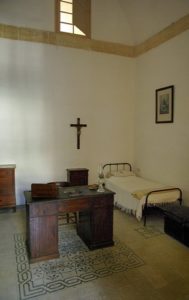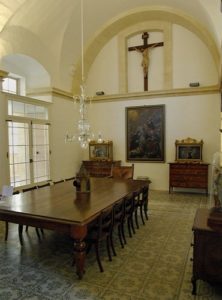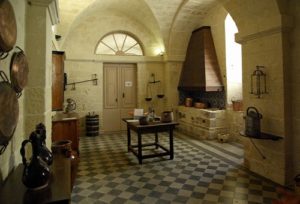The Carmelites established a priory in Mdina in 1659. At its height the monastery would have held 50-55 friars. Now only two are left and one lay brother. They live on the second floor and celebrate mass every morning. The Monastery was open to visitors to help fund its restoration.
The Priory is a massive square building around a central courtyard with cloisters and occupies a complete block on Triq Villegaignon. A small bill board outside the door is the only sign it is open. Through the door is a small cafe on the right. The ticket desk is in the corridor round to the right. Entry was €3 and it is possible to hire an audio guide for an additional €2 although there is a certain amount of written information in each room. The web site refers to guided tours so we asked about one. Fortunately there was a guide available. We found this useful as it gave us chance to ask questions and seek clarification over things we didn’t understand. Unfortunately we only had an hour in the museum as it now shuts at 4pm rather than 5pm. We could have done with a lot longer.
We began in the oratory, a small rectangular room with wooden stalls round the sides and pale painted walls. The friars meet here to chant. It contains a gilded altar made in 1670. Above is a painting of Our Lady of Carmel giving the scapula to St Simon Stock. In front are two statues, St John on the left and St Paul on right.
Next is the kitchen with a wood burning limestone stove with three burners and decorative tiles above. There is a collection of copper pans, some much mended, chopping block and cleaver. Lay brothers worked in here as friars were not allowed in.
The large refectory next to the kitchen is a very stylish room with a patterned marble floor, patterned wallpaper and a painted ceiling from 1750. There are paintings of Carmelite saints on the walls. During meals, a friar would read the Bible from a small wooden pulpit on the wall with a painting of Our Lady of Trapani above. Meals were eaten in silence until 1960s when the rules were relaxed.
The pantry is a small wood panelled room with glass display cabinets. It contains oil lamps, traditional clay pots (ilbaqra) used for cooking rabbit and the little wicker baskets for making gbejna (small round goat’s cheese).
The friars assembled in the Chapter Room to discuss and decide upon important issues. This is a large, rather plain room with a large table surrounded by chairs with a larger chair for the head friar at the top of the table. On the table is the ballot box. Each friar had two marbles, one black and one white, which he dropped into different compartments to vote for or against a motion. There is a large portrait of St Celia on the wall. This is made up of two pieces as it was on the outside of the doors of the church organ. There are small display cases with Carmelite Saints and a large wooden wall cupboard to hold important documents.
The Cloisters went round the sides of a large central courtyard with a well. The corridor is now enclosed with windows. The friars cells opened off this. One is open for visitors to look into. It is simply furnished with a small bed in a corner with spittoon beside it. There is a small open cupboard with shelves which has a spare blanket and a bowl and jug for washing. The slop can is on the floor below. There is a table and chair for studying, bookcase and a small altar for prayers with a rosary and scourge on top. Above on the wall above is a small crucifix.
In a small room off the corner of the cloisters was a wooden bier used to carry the body of a dead friar to the crypt for burial. It was not customary to place the body in a coffin.
The vestments room has examples of different ecclesiastical vestments made by cloistered nuns. Different colours were worn at different times during the year. On a wall is a large painted wood monstrance (?girandola in Maltese). This was used to hold the host which was placed inside a special container called an ostensorium. This was placed on the high altar for adoration of the people for three days during Lent and on other Holy Days. There is a display of church silver including chalices and small silver plaques given in thanks of prayers answered.
The Sacristy has a large table and storage cupboards. Off it is the robing room with a very ornate marble lavabo used for ritual washing. There is a fluted basin with a face on the bowl. Above are cherubs pouring water out of jugs with scrolls, garlands and quotations. On top is a statue of the Christ Child holding a cross. The room was used by priests and their attendants to put on their robes and pray before a Service. It leads into the church.
The church was built between 1660-75 and was the first elliptical church and dome in Malta. It has recently been restored and looks good. There are six side altars round the church. The two centre side altars have a large and very decorative arch over them. The other altars are smaller and have small domes above. Each altar has a painting of a saint. By one altar is a picture of Malta’s first saint canonised by John Paul II.
The arches above the smaller altars have blue paint with red carvings and gold sides. The painting on the dome represents the Glory of the Blessed Virgin Mary of Mount Carmel. The wooden processional statue of Our Lady of Carmel holding the scapular dates from 1765.
The choir behind the high altar has wooden stalls used by the friars, with a big book stand for the choral book used during sung services. On the wall is a large painting of the Annunciation surrounded by an ornate frame. Below is a large marble high altar with big candle sticks and a box for host. There is a small mass altar in front of it.
This was an excellent and well worthwhile visit. We wish we had allowed more time for it.





